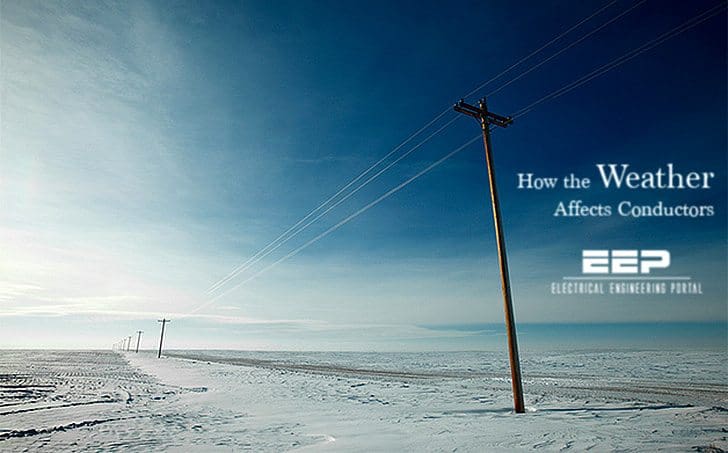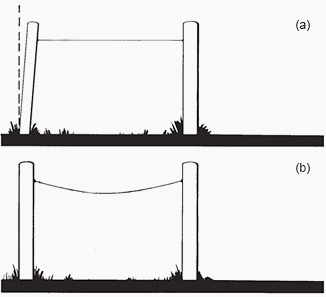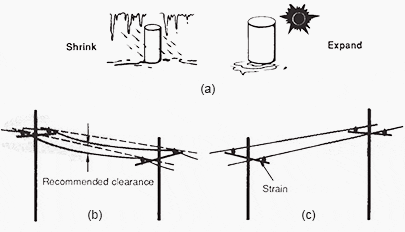Sag
Notice how a conductor is strung between poles. It is not pulled tight; it sags. In hot weather it sags even more than in cold weather. Consider the analogy of the clothesline.

A tightly strung clothesline as shown in Figure 1a puts a much greater strain on the poles which hold it at either end. Adding the weight of wet clothes to a tightly strung line might even pull the poles out of place. However, using a little more rope and allowing the clothesline to dip a little (see Figure 1b) would relieve this pull considerably.
When metallic wire is strung tightly, it produces a greater strain on the insulator pins and on the pole. Scientific sag is an important factor in stringing wire.

A line sags more in hot weather and less in cold weather. The reason for this is because conductors expand in hot weather; in other words the length of the conductor increases as the temperature increases.
If the wire were strung without sag, it would snap during cold weather. On the other hand, there is a chance a wire strung with too much sag would dip below the specified clearance in warm weather (Figure 2).

For copper conductors, the change in length within a temperature range of 100′ to 0° is over 5 feet per 1000 feet; for aluminum the change is almost 7 feet.
Besides the temperature, there are other factors that must be considered in determining the sag of a conductor, for example:
- the length of the span,
- the weight of the conductors,
- wind, and
- ice loading.
Reference: Guide to Electrical Power Distribution Systems – Anthony J. Pansini (Get hardcopy from Amazon)











Good article for basic understanding of sag of bare conductor.For the last two
paragraphs I think the minimum height of conductor above ground and temperature rise of
the conductors are also the factors that should be taken into account for determining sag..
How do you calculate capacitance of sag lines in practice?
IT IS QUIET EASY TO UNDERSTAND COMPARE OF ALL HARD COPIES WITH PICTORIAL WAY..
VERY USEFUL.
how can i download this articles in pdf format from EEP?
thank you
YOU JUST CLICK BY MOUSE, RIGHT CLICK AND ADOPT OPTION SAVE AS AND SAVE PDF IN UR DISK.
As sag increases wont the capacitance of the line change(decreases). This will affect the line capacitance and hence the bus admittance matrix in the power flow equations. So power flow controller would have to take these calculations in mind while dispatching of power else the line may get damaged.
lacks in detailing of the topic….
well the article lacks in detailing, the details provided in the article can be understood by common scene..
please make an application of EEp for windows operated phones..
how can i download this articles in pdf format from EEP?